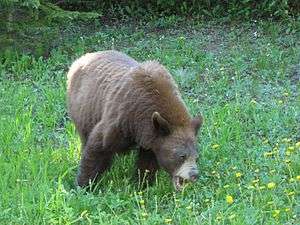Hypocarnivore

A hypocarnivore is an animal that consumes less than 30% meat for its diet, the majority of which consists of non-vertebrate foods that may include fungi, fruits, and other plant material.[1] Examples of living hypocarnivores are the black bear (Ursus americanus), binturong (Arctictis binturong), kinkajou (Potos flavus) and humans.
The evolutionary division of carnivory into three groups, including hypercarnivore and mesocarnivore, appears to have occurred about 40 million years ago (mya). The term hypocarnivory is used with increasing frequency in describing early Canidae evolution, and reliance upon that survival strategy has a documented history in North American Borophaginae during the Miocene (23.03 to 5.33 mya). Twenty-five species of hypocarnivore co-occurred on the North American continent 30 mya.[2] A shift from hyper- to hypo- occurred at least three times among Oligocene and Miocene canids Oxetocyon, Phlaocyon, and Cynarctus.
Large hypocarnivores (Ursus) were rare and developed in the mid-to-late Miocene-Pliocene as Borophaginae became extinct.
Dentition
Examination of dentition shows that postcarnassial molar volume expands with hypocarnivores while decreasing in hypercarnivores.[3] Prohesperocyon (38 mya—33.9 mya) displayed a shift in relative proportion between slicing and grinding functions indicative of a dietary shift away from vertebrate foods to one including fruits.
See also
Sources
- ↑ Van Valkenburgh, B. "Déjà vu: The evolution of feeding morphologies in the Carnivora". Oxford Journals. Retrieved January 26, 2014.
- ↑ Wang, X., Tedford, R.H. and Taylor, B.E. (1999). "Phylogenetic systematics of the Borophaginae (Carnivora: Canidae)". Bulletin of the American Museum of Natural History. 243: 1–391.
- ↑ Ewer, R.F. (1973). The Carnivores. Ithaca: Cornell University Press.